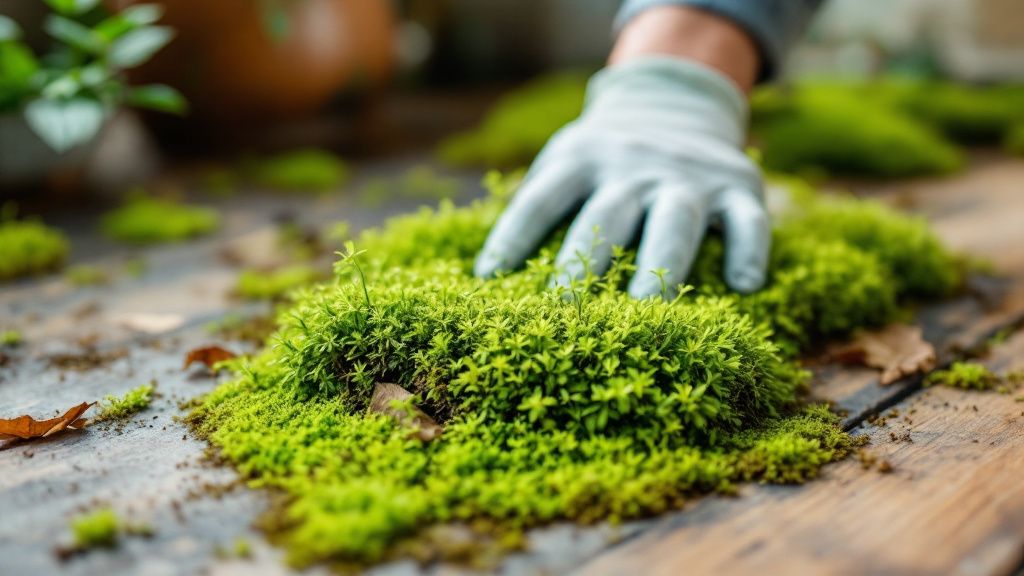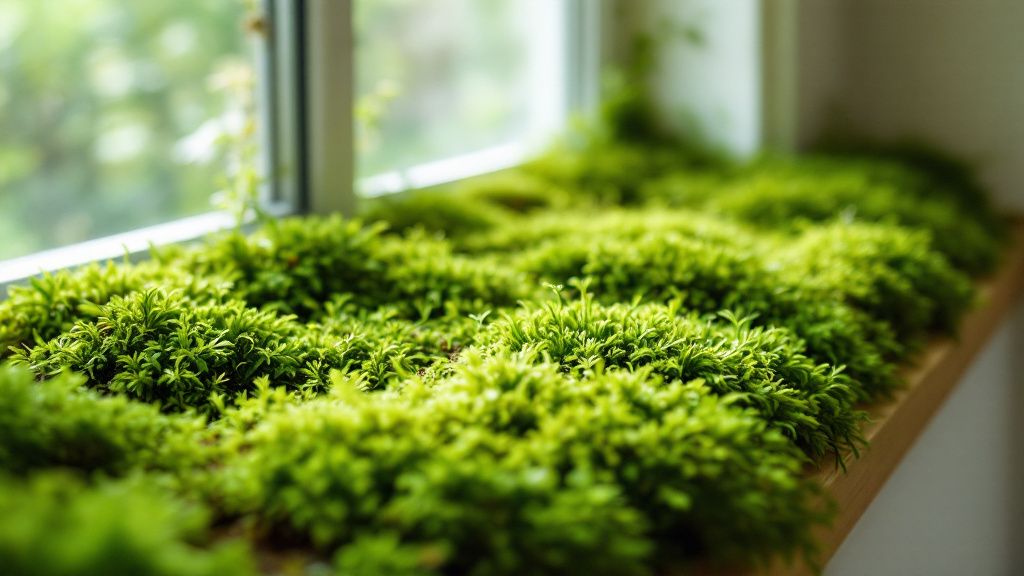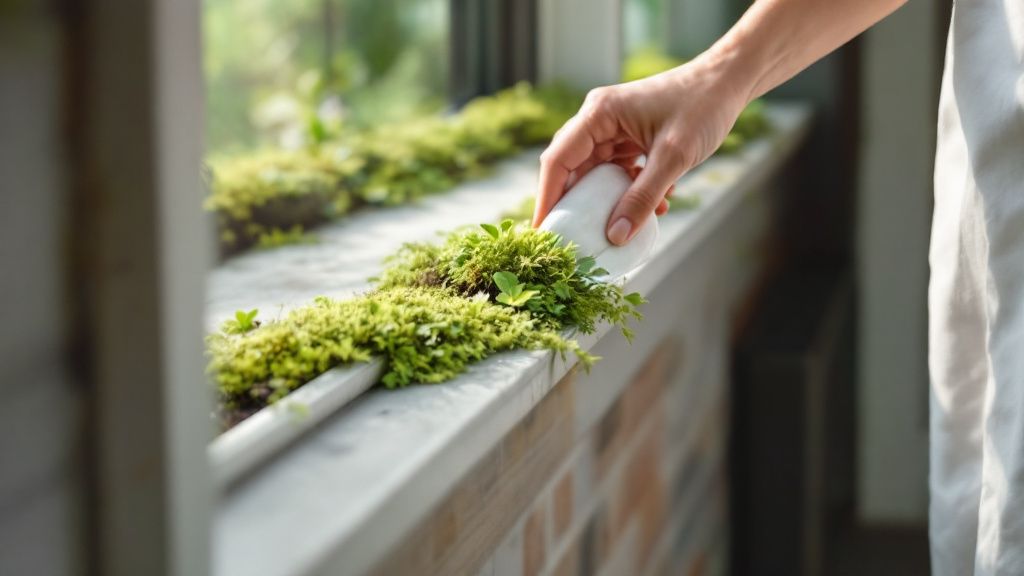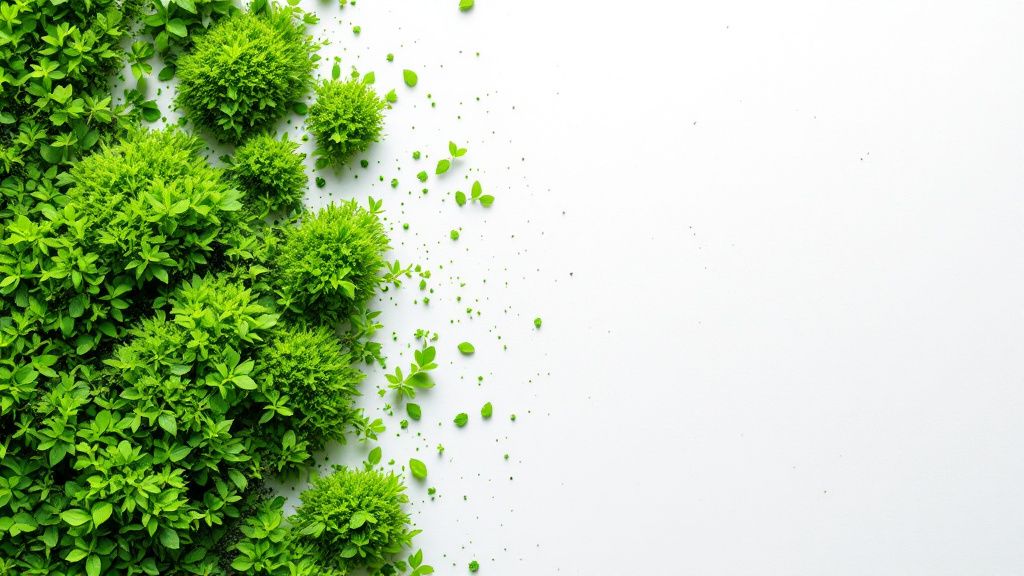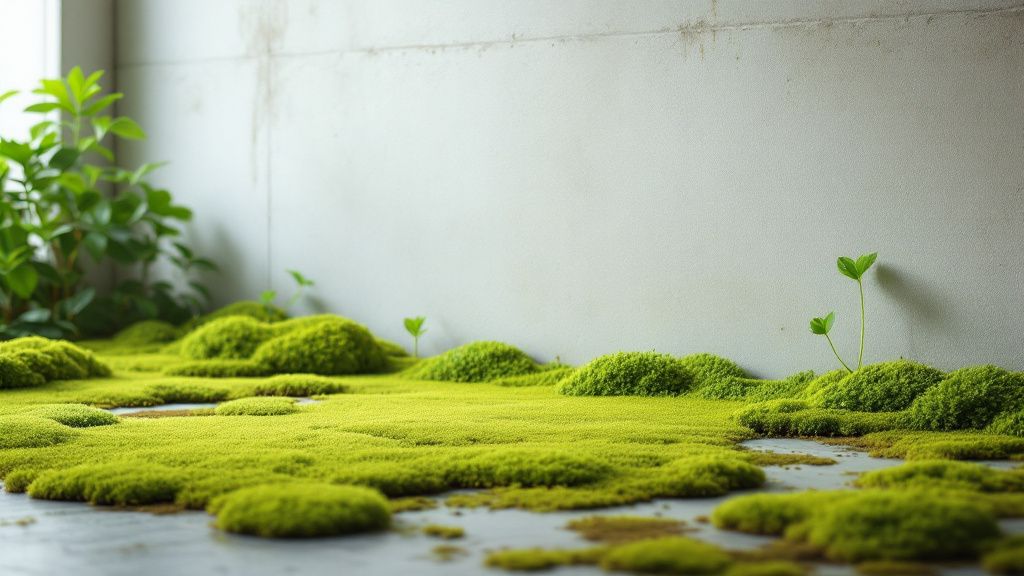Understanding how to manage moss indoors is crucial for maintaining a clean and healthy home environment. Moss tends to thrive in damp, shaded spots, making it essential to address moisture issues in your living spaces. Observing areas near windows, basements, or places with plumbing may reveal the initial signs of moss presence. If you notice unwanted green patches, knowing the best ways to get rid of moss can save your home from extensive growth. Simple solutions, such as increasing sunlight exposure and reducing humidity, can be effective preventive measures. For tougher infestations, moss removal techniques, including pressure washing, can be employed to efficiently clean affected surfaces. Comprehensive moss cleaning solutions may vary, yet they often involve a combination of manual removal and chemical treatments. Consulting moss cleaning services can also be beneficial when dealing with widespread moss issues. Being proactive by learning how to prevent moss through regular inspections, proper ventilation, and moisture control will keep those green intruders at bay, ensuring a moss-free household.
Understanding Moss Growth
Why does moss grow in your house, and how can it affect your living space? Moss typically grows in moist, shady environments where sunlight is minimal and condensation is frequent. This growth can be especially common in areas of your house that have poor ventilation or issues with excess moisture. Understanding how moss thrives is the first step in implementing effective moss cleaning solutions and preventing future growth within your home.
In identifying moss in house, recognize it usually appears in places like bathrooms, basements, or around leaky windows. Its presence is not just an aesthetic issue, as it can retain moisture, sometimes leading to mold growth and structural damage. By pinpointing these environments, you can take steps toward moss removal that will keep your indoor spaces dry and welcoming.
Exploring the best ways to get rid of moss involves several strategies that you can apply right away. Routine cleaning and increasing exposure to natural light can make a significant difference. When these efforts aren’t enough, pressure washing moss from surfaces can offer a more robust solution. This method ensures that moss, along with other debris, is efficiently washed away, leaving your house fresher and less susceptible to regrowth.
If moss growth is extensive, professional moss cleaning services might be necessary. These experts have the right tools and techniques for deeper cleaning, ensuring your home remains safe and pristine. They can also offer guidance on how to prevent moss from taking hold in the future—such as advice on maintaining better airflow and managing humidity levels in at-risk areas.
Addressing how to clean moss indoors is about persistence and vigilance. By regularly inspecting potential problem areas, fostering a drier climate, and sometimes seeking expert help, you can keep moss at bay. Emphasizing preventive measures alongside removal efforts will contribute to a healthier and more visually appealing living environment.
Causes of Indoor Moss
Dampness and darkness provide a perfect environment for moss growth in your home. Areas with continuous moisture, like basements or poorly ventilated bathrooms, are prime spots for these green invaders. When condensation frequently settles, it becomes a breeding ground for moss, signaling potential structural concerns and impacting your home’s aesthetics.
Think of moss in your house as an uninvited guest at a party. Just like an unwelcome guest thrives on a neglected open door, moss flourishes where you allow moisture or darkness to persist. Addressing these conditions is vital for preventing its spread and incorporating effective moss cleaning solutions.
Improper insulation can also contribute to moss growth by allowing cold air to meet warm surfaces, creating conditions ripe for condensation. This interaction not only supports moss development but could also lead to mold formation. Ensuring adequate insulation and ventilation can mitigate these risks, providing a drier, less hospitable environment for moss.
Leaks from plumbing or poorly sealed windows can contribute to indoor moss problems. Water leakage creates damp patches where moss can easily take root. Regular inspections and maintenance can aid in detecting these issues early, assisting in moss removal and keeping your home clear of unwanted growths.
Preventive Measures
Controlling humidity levels is a fundamental step in preventing indoor moss growth. Utilizing dehumidifiers, ensuring proper ventilation, and allowing sunlight to penetrate your living spaces can significantly reduce moss-friendly conditions. Increasing airflow and maintaining a dry environment are simple practices that help in how to prevent moss from establishing a foothold in your home.
Regular maintenance checks can also play a crucial role in deterring moss development. Inspecting windows, roofs, and pipes for leaks helps in early detection and reduces the risk of moss forming. Fixing leaks promptly prevents water from seeping into places where moss is likely to thrive, enabling a more effective moss removal strategy.
In the next few years, advancements in smart home technology are likely to make monitoring indoor conditions easier and more efficient, enhancing your ability to manage moss risks. Through real-time alerts and automated systems, you’ll be better equipped to maintain moisture levels, limiting opportunities for moss to grow.
Choosing appropriate moss cleaning solutions and seeking advice from moss cleaning services can further bolster your preventive measures. Professional tips might include using specialized paints or sealants on surfaces prone to moss. By consulting experts, you can tailor a prevention plan that ensures your house remains comfortable and moss-free.
Effective Moss Removal Techniques
Physical removal with tools like scrapers or brushes is often the first step in addressing moss in house. This method can effectively dislodge and remove significant moss buildup from accessible surfaces. This approach, however, requires caution to avoid damaging underlying materials, making it essential to choose the right tools and techniques for each area.
On one hand, a gentle approach with manual removal is praised for preserving surfaces, while others argue that chemical solutions offer a quicker and more efficient moss removal method. Chemical treatments can penetrate more deeply to eradicate moss roots but should be used judiciously to avoid harming nearby plants or pets.
Another popular method is pressure washing moss from external surfaces like driveways or patios. This technique utilizes high-pressure water jets to blast away moss, delivering a thorough clean that’s hard to achieve with manual methods. Pressure washers are powerful, so it’s important to use them carefully to prevent surface damage.
Seeking professional help through moss cleaning services can be advantageous for extensive or hard-to-reach infestations. Experts have both the experience and equipment suitable for eliminating moss while minimizing risk to your property. Their knowledge can complement your efforts, providing insights on long-term prevention and tailored solutions for ongoing moss challenges.
Professional Help vs DIY
Choosing between professional help and DIY methods for moss removal depends on the extent of the infestation and your comfort level with handling the task. For minor cases, DIY approaches involving simple cleaning solutions can be effective. When tackling such projects, using homemade remedies or store-bought moss treatments allows you to address the issue at your own pace.
Engaging moss cleaning services could be particularly beneficial for extensive moss problems or when it involves areas that are hard to access. Professionals are equipped with specialized tools and expertise to tackle stubborn infestations, ensuring a comprehensive clean that minimizes the risk of damage. Employing their services might come at a higher cost but could save you time and effort.
Looking ahead, the approach to moss removal is expected to evolve with advances in green technology and eco-friendly solutions. Emerging products and methods will likely focus on sustainability and safety, providing options that are effective without causing harm to the environment. These innovations could make professional services more appealing as they integrate advanced, environmentally conscious techniques.
Balancing cost, time, and effectiveness will guide your choice between professional help and DIY solutions. Each approach has its advantages, and your decision may also be influenced by future developments in moss management technologies that might make certain options more accessible and efficient.
Long-Term Solutions
Maintaining proper ventilation and moisture control are essential components of long-term solutions to prevent moss growth in your home. Ensuring that your house has adequate airflow reduces the chance for dampness to settle, creating an environment where moss struggles to survive. Paying attention to high-risk areas like basements and bathrooms can significantly diminish moss presence over time.
In the next few years, advancements in home design and technology are likely to integrate more efficient humidity and temperature control systems. These innovations will enhance your ability to maintain optimal indoor conditions, keeping moisture at bay and reducing the likelihood of moss regrowth. Such systems could become a staple for homes prone to dampness issues.
Regular maintenance checks on roofing, windows, and plumbing are pivotal to long-term moss management. By identifying and repairing leaks promptly, you reduce potential breeding grounds for moss. An ongoing inspection routine helps you stay ahead of infestations, ensuring your home remains a resilient barrier against unwanted greenery.
Utilizing preventative treatments on surfaces susceptible to moss, such as treated paints or barriers, can offer durable protection against future invasions. These treatments, combined with vigilant home care practices, contribute to a comprehensive strategy that keeps moss away effectively. Employing these long-term strategies provides peace of mind, protecting your home from persistent moss challenges.

